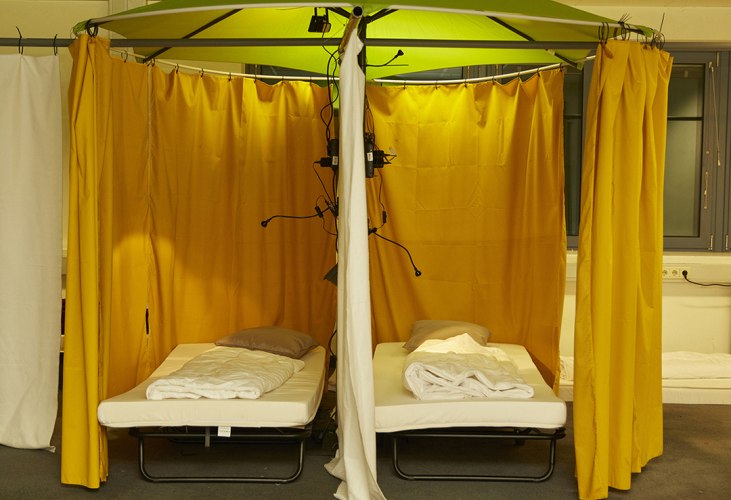Description of the project by Caramel Architekten
A huge advertising banner hanging on the traffic-facing façade of an insignificant 1990s building promotes the property: “3,700 sqm of office space to rent”. Below this, the logo and telephone number of the agent, the traffic rattles by. Who knows how long this building - which is certainly no object of desire – has stood empty. It looks like one of those many properties in the city which are hard to let, the actual number of which is very hard to determine. The official vacancy rate for office real estate in Vienna is currently around 6.6 per cent. Buildings like this – dated infrastructure, average location – have a difficult time on a saturated real estate market. But is it really empty? Some windows are tilted, some wide open, washing hanging over the parapet and a glimpse of material through the fourth floor pane – a golden curtain?
For days, weeks, months around 280 refugees have been living in the former offices. These are mostly families from Syria, Iraq and Afghanistan, who are waiting in this Caritas emergency shelter for their asylum decisions and for their allocation to long-term accommodation. Safeguarding privacy – marking a place where someone can be alone, undisturbed by external influences – was, for Caramel Architekten, the first and most important subject of their intervention and they saw the time limit as a condition of - rather than a limitation on - their thought process. In order to improve temporary living together in a residential community of this size as quickly as possible the architects initially concentrated on a clearly defined immediate measure based on two key questions:
1. How can one create privacy at minimum cost and in a very short time without intervening in the substance of the building?
2. How can one increase the permeability of the building to the outside as a way of countering the isolation of the residential community and generating openness? Safeguarding privacy through the creation of suitable separating elements and opening the community through the creation of connections to the outside were seen not as isolated subjects but as two sides of the same question.
The basic structure of each unit is easily slotted together or taken apart in a matter of minutes regardless of the spatial conditions. The module made from simple plastic pipes defines the basic spatial limits and the visual and atmospheric enclosure is provided by textile separating walls which combine intimacy with a sense of security. The unit for a family of four consists of a parasol with two sleeping places and two secondary spaces divided by partitions in which there are two extra beds. The vertical elements act as service runs with each having a light and a multiple socket. The basic structure which can be expanded at will only touches the building at its extremities and most work is involved in sewing closable pockets onto the “walls” which can be used for the storage of personal belongings.



































![Aga Khan Award for Architecture 2013. Finalist. [Tripoli] LebanonSasa" con zonas adyacentes del campamento. Fotografía © Abdelnaser Ayi Aga Khan Award for Architecture 2013. Finalist. [Tripoli] Lebanon](/sites/default/files/styles/mopis_home_news_category_slider_desktop/public/lead-images/ml_nahr_el_bared_01_1024.jpg?h=199d8c1f&itok=b4YXaIZZ)






